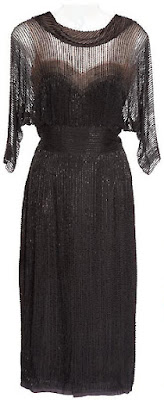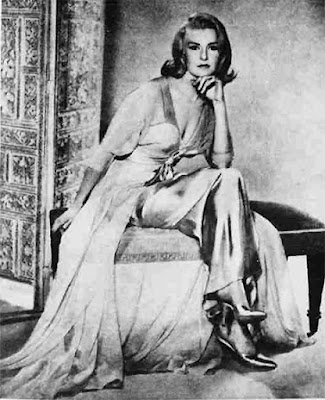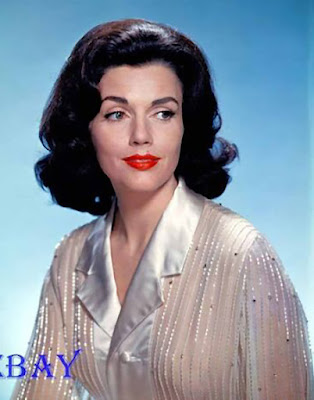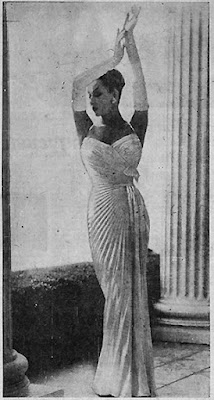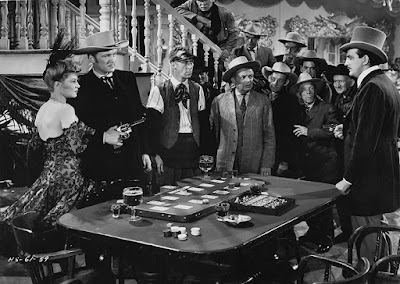From the Terrace would be Travilla's first film since leaving Fox in 1956. After concentrating on getting his private label successfully running, he finally returned to the studio as a freelancer. Hedda Hopper announced in her November 19, 1959 column, "Woodward has twenty high-fashion styles in From the Terrace and will give a one-woman fashion show by Travilla, who's designing her costumes."
Terrace would be the first of four films Travilla would work with Joanne Woodward (and husband Paul Newman in two of them) over the next decade. Woodward portrayed Mary St. John, the wife of Newman's ambitious young executive. The latter chooses a loveless marriage and an unfulfilled personal life in exchange for a successful Wall Street career. The film co-starred Myrna Loy, Ina Balin, with Barbara Eden in one scene. Mary's wardrobe would be an expensive one. In several articles, director Mark Robson boasted of the $70,000 budget and the fact that the actress would wear no undergarments beneath her costumes, many of which were nightgowns, negligees, and nighties.
He told the Dallas Morning News in 1988: "Joanne was living in New York, and we were showing at the Plaza that season. I went to see her in her flat down around 14th Street. She wore a turtleneck sweater, a big circular tweed skirt, flat shoes, and black socks. She felt a bit skittish about attempting a chic, high-fashion look. She said, 'I look best in a tailored shirt, a nice belt, and an easy skirt. She felt her hips were too big, but I explained that this film required her to be clothed in tons of beautiful outfits. I asked her, "Do me the favor of coming and looking at the collection."
Wearing oversized sweaters and skirts, she attended a show with her girlfriend. After viewing the collection, she told Travilla, "They're beautiful, but I can't wear these clothes." I told her, "Let me pick out five dresses, and if you tell me I'm wrong, I'll be happy to give you a tweed skirt and sweater. After she tried on all five, she said, 'You can do anything you want.' She ended up wanting all the film creations for her own wardrobe."
Travilla designed twenty-one costumes from luxurious fabrics from France and Italy, costing $50-60 a yard, including warp-printed silk brocade and iridescent mylar velvet, simulating a beaded effect and peacock feathers. Travilla later told the press, "The assignment was a dream. All of the feminine roles are those of wealthy, sophisticated women. He told the Arizona Republic fashion critic, "They do the nastiest things while wearing the prettiest clothes."
"Joanne is fresh, delightful, and a great actress. However, in all her previous roles, she has never yet been seen in high fashion; nearly all required her to appear in extremely simple, even dowdy, clothes.
For one outfit, Travilla had more trouble with his director than the star. Robson desired for Woodward to have a full-length mink coat. Travilla argued that the character would have a more refined attitude towards the fur. "Actually, both the director and I wanted this wardrobe to reflect a woman of elegance, good taste, and wealth. So, while opulent and expensive, it never goes 'overboard.' It doesn't 'drip with mink' and that sort of thing. He created a gold silk brocade coat with a foliage pattern made in gold thread and lined in chocolate silk; only the collar and cuffs were mink.
They reflect the mood of "Cafe Society," with understated elegance and detail. Woodward wears blacks, blues, deep browns, and silver grey. The one area Travilla felt comfortable going a little "overboard" was in the boudoir. "This was done to help delineate the character because, in the course of the story, our well-bred heroine becomes the niftiest kind of cheater. So, I'd say the negligees she wears while 'pursuing' either her husband or the other man are not exactly 'understated.' Otherwise, the chic clothes that are a color part of this film are the types for which my own couture line is famous."
The designer would use his advantage to create a clothing line based upon many of the costumes.
Travilla adapted many pieces from the film for "fashion-minded" women across the country: this slim putty-silk sheath. Topped by a seven-eighths coat styled with a cutaway front and a two-button closing at the waistline, Woodward's film version was executed in beige wool with a deeper beige collar for better definition on the screen.
Ina Balin



.jpg)
.jpg)
.jpg)

.jpg)
.jpg)
.jpg)
.jpg)
.jpg)
.jpg)


